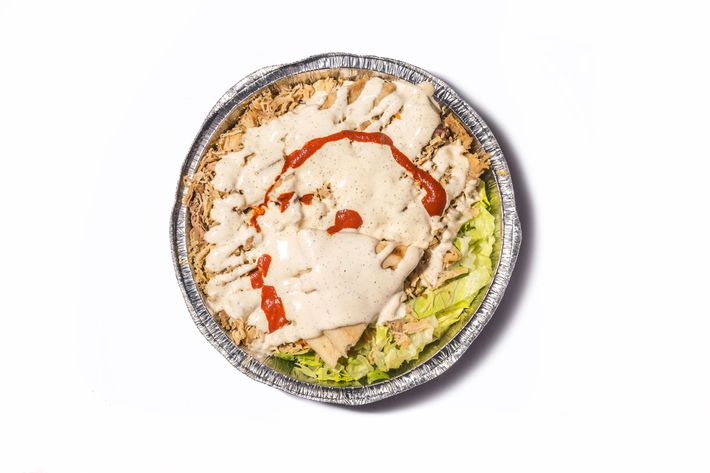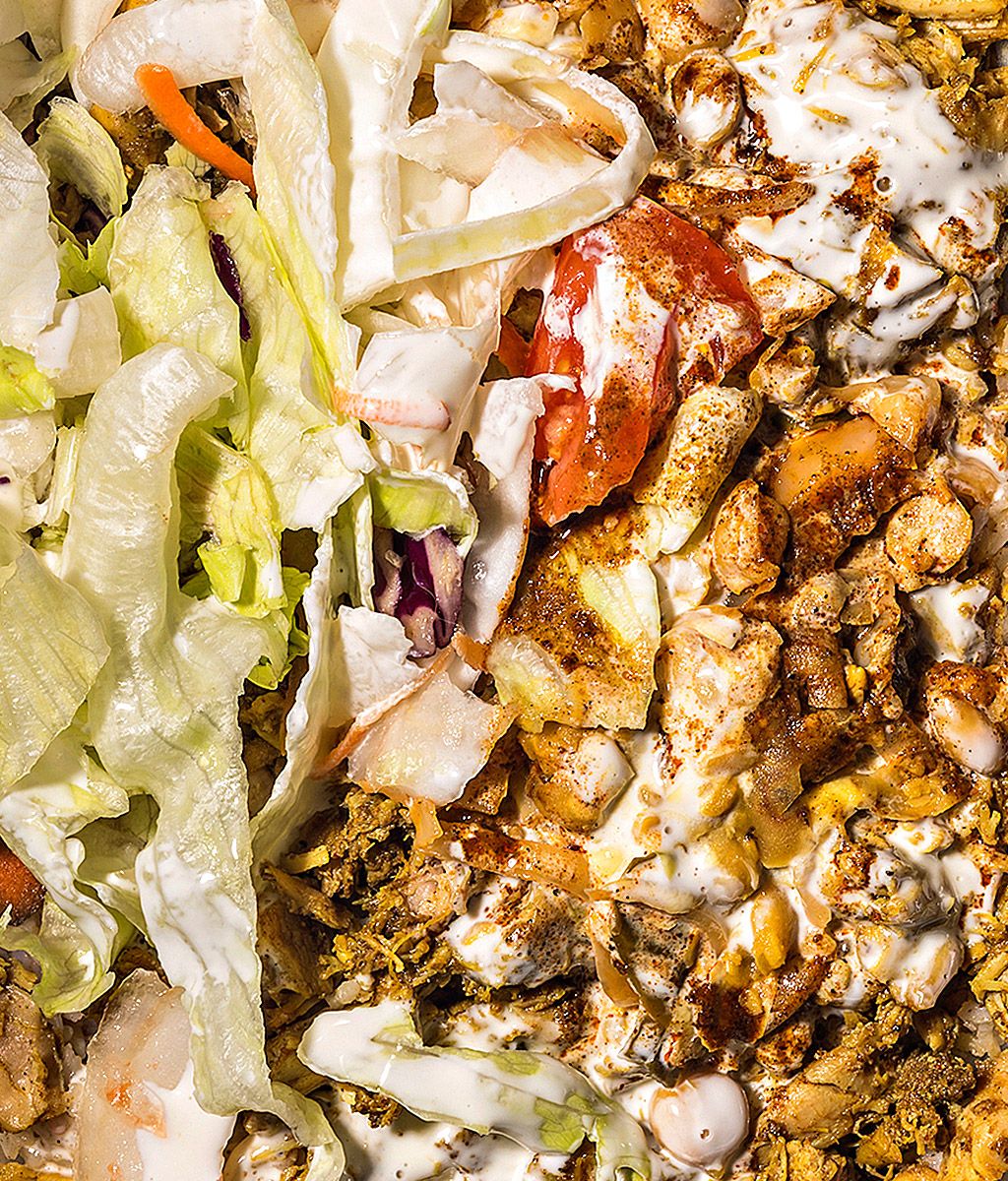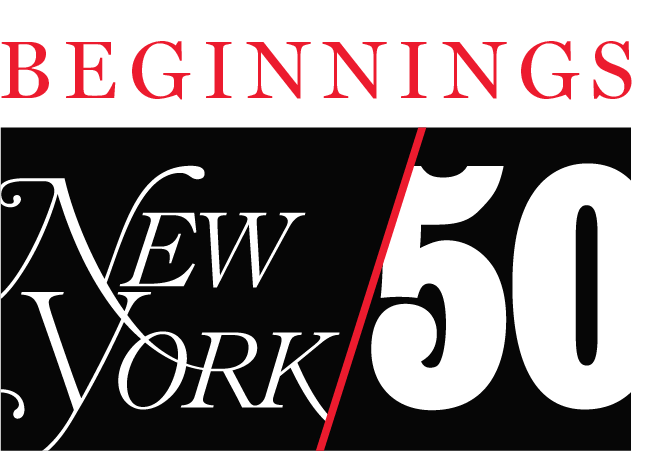In celebration of New York Magazine’s 50th anniversary, this weekly series, which will continue through October 2018, tells the stories behind key moments that shaped the city’s culture.
On corners all across Manhattan — and every other borough — the faint, distinct smell of griddled, curried meat wafts through the air. The carts and vendors are varied, but the dish they prepare is the same: chicken or lamb, turmeric-hued rice, maybe some shreds of iceberg lettuce and a few slices of tomato, all covered in a mix of rich white sauce and spicy red sauce. The combination — variously and casually referred to as “halal food,” “chicken and rice,” or just plain “street meat” — is now a staple of the city, as central to New York’s food scene as hot dogs or pretzels ever were, even though it didn’t exist in its current form until 1990.
For most people, it’s never been entirely clear how exactly this meal, which pulls inspiration and ingredients from all over the world, came to be. Grub Street spoke with the vendors, writers, and other halal-cart enthusiasts who were there through the various stages of its evolution to get the real story of how the dish became inextricably linked to the streets of New York.
Zach Brooks, Founder, Midtown Lunch: Street food has always been that entry-level job for immigrants, whether it was Italians and pizza, or Greeks and gyros. When Egyptian and South Asian immigrants started arriving in the ’80s and ’90s, they took over the mantle of these carts. Around the same time, the taxi business started being taken over by a lot of Muslims. The place where people picked up and dropped off their cabs was centralized in west midtown, where a lot of these carts were.
Konstantinos Dragonas, Manager of Tony Dragon’s Grille: Tony’s started as a hot-dog cart, but eventually, Tony decided he wanted to bring something more. He was inspired by where he came from, the Greek isles, and started adding Greek dishes to the menu. One of the most popular was a marinated, grilled chicken breast served with pita bread, tzatziki sauce, fresh tomatoes, red onions, and lettuce. He was one of the first carts to start serving Greek food, and helped a lot of other Greeks get started in the business. So it’s likely that when people from the Middle East and Egypt started coming in, they saw Tony’s as this very popular cart, and did in fact try to replicate it, and put their own twist on the dishes. I say that very modestly.
Muhammad Khan, Manager, Trini Paki Boys: My dad [co-owner and Trini Paki Boys founder Abdul Sami Khan] was the first person to start serving that dish, mainly to cab drivers. He sold hot dogs when he started the cart in 1990. But he realized one day he wanted to change it up, so he made halal chicken and rice. I think this was about 25 years ago. Everyone else saw that, thought it was a good model, and copied him.
Fatima Khan, Co-owner, Trini Paki Boys: My husband and I both grew up eating chicken and rice, and both of us love spicy food. He is from Pakistan and I am from Trinidad. We knew the cuisines would go together, his rice with my curry chicken. When my husband and I came to the city, there were no halal carts. We decided to do our own.
Max Falkowitz, Executive Digital Editor, Saveur: Trini Paki Boys was the first cart I’d visited where they were doing something outside the standard formula, and it was a case of fusion flavors that just worked perfectly. It’s one of the strongest examples of “halal-cart food” as its own cuisine: something that grows and changes with the people who make and eat it.
Fatima Khan: I remember very well when we went to go get the judge to get our certificate. He asked us, “What is the meaning of ‘halal’?” We had to explain to the guy what that meant, because we were the first ones trying to do halal food.
Brooks: Trini Paki Boys may have been the first to serve chicken and rice, and their version has remained fairly unique. The Pakistani influence came through in the rice and spices, and the Trinidadian pepper sauce was unlike any hot sauce I’d found on a street food cart in New York.
Fatima Khan: Our formula is nothing special. Turmeric, chili powder, curry powder. It’s the balance of salt and pepper — that’s the secret. These are recipes like we make at home. I never went to school for cooking. I learned from my grandmother and mom in my kitchen.
Ahmed Ali, Manager at Halal Guys: We were not the first. There were some people before us. Halal Guys started as a hot-dog stand in midtown. But people kept coming up to us, asking if we had food that was halal. So we got the idea: How can we serve the halal people? We didn’t want too many combinations. From the beginning we tested out gyros, and we saw that most people were asking for chicken, so those became our targets: gyros and chicken.
Brooks: As Muslims took over the taxi business, you had a cart — the cart, on 53rd and Sixth — that started promoting halal food as a thing taxi drivers could eat before and after their shifts, picking up their cabs in Hell’s Kitchen. There is where the whole halal thing and street food came together, and became this thing that people started talking about.
Ali: The recipes came from our chef who joined us. We started to ask customers about the food, and then we would add something. We did a lot of research in figuring out what people like.

Dave Cook, Founder, Eating in Translation: If you go to Steinway Street in Astoria and go to an Egyptian joint there, you won’t have anything like a plate of street meat. It is meant to be something that is close enough, an acceptable version that sort of tastes like the kind of food you want.
Dale Talde, owner and chef at Talde: When you’re talking about chicken and rice, it’s about four things: chicken, rice, white sauce, and red sauce. How they all play together and balance. The rice is the perfect starch combined with spices they use to marinate the chicken, the cooling down of the white, and the heat of the red. It’s also about how you can shovel it all together with ease. Literally, shoveling it into your mouth.
Brooks: I have a theory that white sauce morphed out of tzatziki, because before the Egyptians, it was the Greeks who ran the food carts. And red sauce was originally harissa, a classic Egyptian sauce. Every cart has its own red sauce and no one calls it “harissa.” No one calls it “tzatziki,” either. Now it’s “white sauce” and “red sauce.”
Dragonas: It’s possible that white sauce was born out of tzatziki, though tzatziki is made with yogurt, cucumbers, dill, and garlic, whereas most halal carts use mayonnaise.
Sheikh Amin, Cook at Kwik Meal: My boss came up with his own recipe for white sauce, taking tzatziki and making it more delicious, with black pepper and other spices.
Muhammad Khan: We keep our white and red sauces a secret — there are so many copycats.
Cook: A lot of times, these vendors weren’t starting their businesses from scratch. They were getting a turnkey business. You have to get your cart stocked at a commissary kitchen, where you hang around with other people with food carts. You hang out at the commissary and are encouraged by other people.
Falkowitz: It’s an easy structure to replicate. The start-up costs are low; there’s a built-in infrastructure; there’s mobility and freedom. To me, it’s the same reason that bodegas and pizza shops are so ubiquitous. You have to set up everywhere because there are only so many street corners.
Brooks: There is no guidance for how street vendors interact with each other. There are constant turf wars. Nobody owns any location, so mafialike conditions have arisen over the years where vendors fight and use intimidation. Like, if you’ve ever wondered why the Van Leeuwen ice-cream truck never parks in midtown, it’s because the one or two times they tried, they were threatened physically. The halal stuff is much more decentralized than ice cream, so you get smaller fights.
Ali: We’ve had plenty of competition. Too many people think this corner is the only location that will give them good business. They position their carts beside us, but they stay for one or two days, and they find out they will never do business like what we do.
Fatima Khan: One day a doughnut guy parked his truck right next to ours. My husband said “You gotta move,” and he said, “No, I am not moving.” My husband got into his cart and said, “You have got to move.” They nearly had a big fistfight. My husband said, “Either you kill me or I kill you.” The guy finally moved his cart! After a while, they became friends. You have to. Everybody has respect, and there is an understanding among vendors. Nobody can just come here. We would have a war.
Muhammad Khan: We all know each other. We are a community.
Ali: We help each other. It is very friendly. It’s not competition.
In 1995, the Times published one of the first stories to bring widespread recognition to the collection of midtown halal carts. Restaurant critic Ruth Reichl wrote of standing on the corner of Sixth Ave and 43rd Street, “It’s hard to believe that you’re not in India or Pakistan,” and declared halal chicken and rice “the best $2.50 lunch in the neighborhood.”
Reichl: I was working in Times Square, and I remember passing the Trini Paki Boys cart, and it just smelled so amazing. I stopped and bought some chicken and rice, and I immediately became a huge fan. I found the flavors so seductive and delicious — that combination of the curry and the chicken, and the crunch of the greens on top. I loved the idea of the lifted-pinky restaurant critic of the New York Times writing a piece saying, “This is how I eat, and you should go try these places.” Food-cart culture is this particularly wonderful urban phenomenon, and one of my goals when I came to the Times was to celebrate New York culture. I wanted to tell people to go out and explore what was there.
Cook: There are a lot of tales that are lost in the fog of late ’80s and early ’90s history. Cab drivers needing something to eat and carts who will sell them something that is halal. Whether that first happened in midtown or whether there were some nascent carts in Little Egypt, you never know because these things were not well-documented. It was the midtown writers and editors that were going to make people notice.
Krishnendu Ray, Associate Professor of Food Studies, NYU: There was something interesting happening in the 1990s — it was the birth of the so-called “foodie” population. People became interested in exploring omnivorousness, in finding places that had an interesting story, and halal carts were just that.
Brooks: At some point around the late ’90s, the bridge-and-tunnel crowd would be stumbling out of bars and clubs late at night, and they started to see the lines forming around these carts. That is where they started to enter the public consciousness.
Dimitri Psiavos, Owner, Broadway Meat Market: When I started my shop [in the ’90s], I was selling mostly to Greek carts — they wanted pork for souvlaki. And then suddenly, the demand for halal meat was big. Muslim vendors were coming in and requesting that I buy it. At that time, I didn’t know anything about it. I’ve been in this country 46 years and my first job was in a meat market. But I was like, “What the heck is a halal?” I started buying it from a purveyor in the Bronx. At first, halal meat accounted for about 5 percent of my business. Now, halal meats are 80 percent of my sales.
Ray: As New Yorkers, we will go and eat stuff that other people will hesitate to try. New Yorkers did that with Jewish immigrants and Italian immigrants. They used to dominate the street-cart business, and now we are doing that with Muslim and Arab immigrants. As New Yorkers, we react to good, cheap food with a kind of open-mindedness and optimism. That is a New York story: We are willing to go where our tongues lead us, which is quite cool.

Muhammad Khan: People would come to see us because someone else had recommended us. It was people who knew to seek us out. That’s when we started seeing the lines.
Fatima Khan: That’s when we started seeing the lines.
Reichl: When I was at the Times, a new reporter decided to do an exposé on how food carts weren’t sanitary. She went around with an inspector and thermometers. I kept telling her, “This isn’t going to make any difference — you think you are going to do this great exposé, but people go to these carts every day.”
Brooks: The fact that we even call them “halal carts” is so funny because to one group of people, that means something very specific about how food is prepared — it’s very religious. But to lots of people in New York, it translates to “chicken and lamb with red sauce and white sauce.” It’s a very different definition.
Muhammad Khan: Some people come and ask if the food is “halal,” but they don’t even know what halal is. All they know is that it means chicken and rice.
Fatima Khan: Some of the other carts are really tasteless. They only go for the name “halal.” They think it is halal, and it is not halal! It’s not actually blessed. I saw a guy selling halal across the street on Ramadan. I said, “It’s Ramadan, are you not fasting?” He told me he wasn’t Muslim. I said “Why do you put ‘halal’ on your cart? You’re giving people the wrong thing to eat — you could get sued.” I think the cart is still there.
Reichl: Trini Paki Boys still holds up to this day. It has to, or people will find the next cart — they will move on.
Muhammad Khan: The only problem now is tickets. It is ridiculous. It used to be 50 or 100 bucks — now it is like $1,000 per ticket, $800 for not having paper towels or not having a thermometer in your cart.
Brooks: Any of the changes that have happened have been at a micro level. It is interesting to see how each of the famous carts becomes famous, and they inspire copycats, and some of the copycat ideas might take hold and become more ubiquitous, but I think it is everybody doing their own thing.
Anita Lo, Chef: New Yorkers must develop a taste for that chicken-and-rice dish from the halal carts just from passing them on the street on a daily basis and inhaling the wafts of browning meat, garlic, and spices. By the time you actually have it, it’s almost part of your DNA — a taste sensation you’ve been expecting for a long time, like an old friend.
Falkowitz: There is a grit that feels appropriate. Styrofoam clamshells speak to the aesthetic of the sidewalk the same way that paper plates do for slices of pizza. There is also an inherent multiculturalism that comes with halal food. You can’t go to a halal cart and not see people of multiple ethnicities lining up for food — that is true everywhere they exist. It is such a great lunchtime experience.
Amin: People have a close connection to this cart. I had a customer who moved away ten years ago, and he recently came back. This cart was his first stop, and he had a picture he had taken of me ten years ago — he came back just to show me the picture and eat my food.
Freddy Zeideia, Owner of King of Falafel & Shawarma:I opened in 2002, after September 11, and people would pass by my cart and say, “You are a terrorist.” But then, during the 2004 blackout, most restaurants were closed by 6 p.m. I was the only one open. I had a line around the block, even though all I had left was chicken and pita. We had the generator powering the van lights, and we didn’t stop serving until we ran out of food. People came up later to thank me for not raising the prices.
Ray: Halal carts cross barriers. Cheap food triumphs over bad politics.
Order Highbrow, Lowbrow, Brilliant, Despicable: 50 Years of New York, a celebratory book chronicling the magazine’s history with powerful images and behind-the-scenes stories from staff and subjects.






